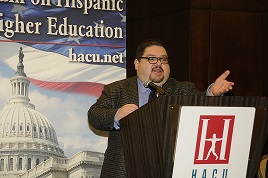March 17, 2016
By Marivel Resendiz
Hispanic millennials and the 2016 presidential elections
Dubbed a unique election year, the 2016 election is including the first real primaries that have a significantly large Hispanic voter population participating in both the Democratic and Republican parties.
In addition, a sizable share of the Hispanic votes may come from millennials who are reaching voting age for the first time, said panelists on March 15 at the HACU 21st Annual National Capitol Forum on Higher Education in Washington, D.C.
"That's what makes Latino voters so unique," said Mark Hugo Lopez, director of Hispanic Research at the Pew Research Center. "The Latino youth are becoming a big part of the election story."
While, historically, Latino and Hispanic voting participation has remained low, this year, minority votes can mean change, said Erin Hustings, senior policy analyst of the National Association of Latino Elected and Appointed Officials. Combined, Latinos and African Americans will account for nearly 12 percent of eligible voters.
"Latinos and African Americans, theoretically, have the power to influence politics in the 2016 election," Hustings said.
"If there is any election to demonstrate our power as young Latino voters, it's now," Urbina said.
